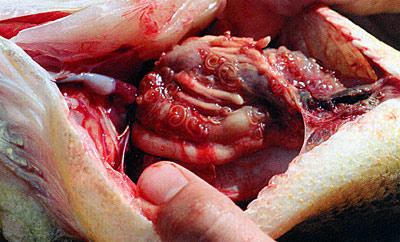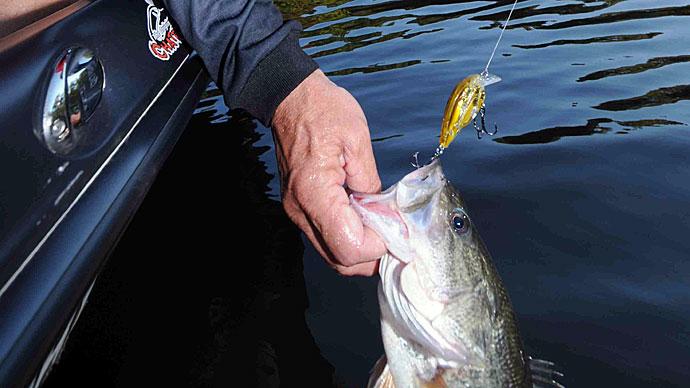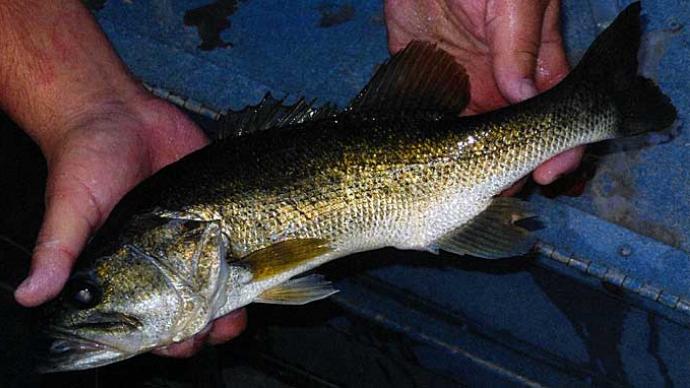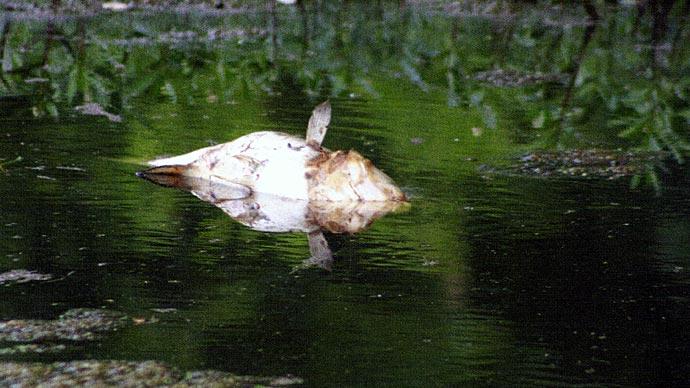
When counseling pondmeisters about fisheries management, I preach the four basic concepts—habitat, food chain, genetics, and harvest. Expounding on those four principles, the conversation often turns to limiting factors. The Number One limiting factor in recreational fishing ponds and lakes is food. I'll tell you, with few exceptions, ponds aren't capable of producing enough natural food to support populations of game fish in quantities today's pond owners prefer. That's why guys like me hound pond owners to harvest, harvest, harvest, selectively. In today's pond management game plans, taking fish is paramount to keeping the whole population dynamic, individual game fish growing, and the food chain productive.
For those people who attempt to minimize the limiting factor of food, what's the next limiting factor? Water quality. Think of it like this. People who wish to do what they can to eliminate food as the first limiter usually provide more food via fertilization, feed the fish, and regularly stock supplemental, natural foods such as minnows, sunfish, crawfish, tilapia, and even small trout during the coolest months—all to bolster the pond's inability to keep up with production naturally, in order to prop up too many game fish.
When people push a pond beyond its natural limits, the second limiting factor soon raises is septic head, and water quality deteriorates. Look at it this way. More food, fed to more fish, creates more waste byproducts. Waste in water yields nutrients, which nature turns into something green. Plankton becomes denser, water color changes, fish production rises, and waste production intensifies. Over time, there comes a tipping point, where waste and nutrients are introduced faster than the pond's water can process it. Not only do we see intense plankton blooms, we'll see a surge in natural toxins permeating the water column. Ever step into the edge of a pond, stir the water, and smell that rotten egg smell? That's what I mean. That's a an exponential increase in pond aeration in this industry. When water can contact the atmosphere quickly, it can expedite cleansing. That's what aeration does.
As good as aeration is, continued introduction of organic matter into a pond leads to potentially toxic circumstances, but pondmeisters with resources are able to keep this situation at bay, too. Not only do these pondmeisters have reliable aeration systems, dominated by bottom- diffused aeration, many have the capability to exchange water via a nearby source, often a high volume well. Others can pump from larger lakes, reservoirs, creeks, or bayous to flush water. At our house, we pump water from the pond bottom to irrigate the yard and gardens, and make-up water comes from rain or a well on site.
When those first two limiting factors are mitigated, what's the third limiting factor? Fish crowding. Nature doesn't appreciate a bounty. When mankind tries to push a pond beyond its natural limits, nature pushes back. I see that as a law of nature. Over the years, I've had the opportunity to work with many landowners who want, "The best of the best—the biggest fish, the most fish."
That doesn't happen without dealing with some heartache.
Here's a thought process.
Fish well fed? Check.
Water quality kept healthy via aeration, added microbes, flushing with fresh water? Check.
Fish crowded? Check.
Whoa...hold up with this one.

What are the consequences of crowded fish? The first, most obvious, is the attraction of outside predators. With this bounty, nature brings forth all kinds of critters that love to bring those numbers back down. Avian predators converge. River otters make their way to dine at such a bountiful cafeteria. Snakes, amphibians, and whatever nature affords make their way to prey, but when the pondmeisters keep predators at bay, then what?
Crowded populations are much more susceptible to infections, afflictions, and disease. I'll always remember a trek to an east Texas fishing club, a well-known one. The caretaker emphasized one of their biggest problems was red sore disease. I chuckled a little bit. A disease, or an affliction, is the result of some pathogen, typically a result of a stressor. This red sore disease has now reached the status of a commonly- described affliction, but is a catch-all title for several possible infections. For us, a basic understanding is important.
When our fish get sick, it is a response to a stressor. Lousy water quality, rapidly changing water temperatures, poor handling offish, overcrowding—something stressful weakens the fish, and sickness happens.
Job One is to identify the problem. Red sore disease manifests itself with obvious lesions on your fish, especially sunfish (including bluegill, redears), Largemouth and Smallmouth Bass. Hybrid striped bass are subject as well, but so are some of the catfish. When you see red lesions or white pasty-looking patches on your fish, you may be seeing this red sore disease.
This particular problem is a manifestation of either a bacterial infection or the result of the impact of a parasite. With just a few infected fish, we don't typically worry about it, but when the numbers push above 10-15%, we often choose a corrective course of action. When we've overcome the odds of the first two limiting factors, we certainly don't want to yield to number three, and watch our precious fish die.
Your job is to recognize what is going on. Fed fish congregate around a feeder, affording the opportunity for a bacterial pathogen or a parasite infestation to spread. So, it makes sense to use that feeder to help alleviate the problem.
More on that in a minute.
How do you know your fish might be sick?
First, their behavior changes. If their normal behavior is strong activity when your feeder tosses out their nuggets, watch for minimal responses. That's a clue. If you catch more than a few fish with lesions, that's a clue. If you see some fish dying with no strong evidence of a reason, such as holes poked by birds, deep-hooked yes-terday, or big cuts, that's a clue. If you go fishing and catch rates drop dramatically, that's a clue.
Follow the clues and follow your gut instinct. When things don't seem normal, they probably aren't. Don't poo-poo that instinct. Act on it. If your water makes a dramatic change in color, that's another clue. Ask for help. Time is of the essence.
Seems every fall we evaluate several susceptible lakes, and sometimes see symptoms of a disease, often due to overcrowding. What do we do? We recommend that landowner medicate some feed and offer it to their fish—with the caveat that we aren't allowed to medicate feed for fish intended for the meat market. For recreational fishing, catch and release fishing, for fish in need, we'll counsel pond owners to add two to four ounces of an over-the-counter antibiotic from the local feed store, mixed with a small bottle of vegetable oil, and drizzled onto a bag of floating fish food, fed to their fish for at least ten days. If that affliction is bacterial, it's cured in a short time. This seems to happen mostly during spring or fall months, especially after a hot summer with a crowded bluegill fishery.
Another viable option is to harvest some fish to decrease the overcrowding. Should you do that? Your call, but don't dare deplete too many of your biggest fish, especially basses and bluegills.
We'll also get some calls each summer when an intensely managed lake or pond loses some of its best predators. While it isn't easy to figure out, oftentimes a few fish simply succumb to the heat. With the summer of 2016 mostly in the rear view mirror, I received three phone calls from anxious pond owners who saw some fish dying. Not many, mind you, but more than a few; enough to cause concern and raise our hackles to investigate.
Without sound clues, it's hard to zero in on the problem. Is the water quality biologically stressing your fish for a few minutes or even a few hours each day, to the detriment of your favorite fish? Is it a fish problem? Could it be a disease? Until we get some distinct clues, there's really not much way to figure it out. So, we'll often randomly collect a few fish, send them to a lab, only to receive a report back that there's nothing wrong with those samples. All we know at this point is a few brethren perished for some unknown reason. Sometimes we have to live with that answer.
Okay, so much for all this talk. What in the world do you do when you suspect an imminent problem? You see the symptoms. What are the solutions? First thing is to make sure your water is healthy. Aerate. Exchange some water. Minimize overcrowding. In a crisis? Call your pond management professional, and work together to have some fish analyzed. If oxygen depletion is the problem, time is critical. Act now. Cut back on feeding during those hottest months, and pay attention to lethargic fish. It's better to cut back on the feed and decrease nutrient input than to force- feed fish that don't intend to eat your offerings.
If you are one of those who have overcome the first two limiting factors, think about over-crowding. If you are still battling the first limiting factor, think about culling some predators and ramping up your baitfish population.
Here's the bottom line. Healthy fish, in healthy water, with plenty to eat, will grow and be happy—up to a point. When they are overcrowded, nature prefers to correct that. Recognize the signs and symptoms. If you are one of the diligent ones to see a problem before a big fish kill, and are able to correct the problem, position yourself to expect the next problem, and fight it before the symptoms manifest themselves. Exactly what does that mean? Keep the water aerated, clean, and happy—and harvest some fish when you see them becoming crowded.
Reprinted with permission from Pond Boss Magazine



